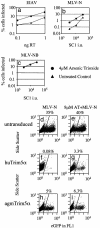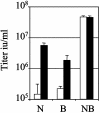The human and African green monkey TRIM5alpha genes encode Ref1 and Lv1 retroviral restriction factor activities
- PMID: 15249687
- PMCID: PMC490011
- DOI: 10.1073/pnas.0402474101
The human and African green monkey TRIM5alpha genes encode Ref1 and Lv1 retroviral restriction factor activities
Abstract
The rhesus macaque tripartite motif containing protein TRIM5alpha specifically restricts HIV-1 infection at an early post-entry step before reverse transcription [Stremlau, M., Owens, C. M., Perron, M. J., Kiessling, M., Autissier, P. & Sodroski, J. (2004) Nature 427, 848-853]. Here, we show that the human and African green monkey (AGM) TRIM5alpha genes encode Ref1 and Lv1 antiretroviral activities, respectively. Expression of TRIM5alpha in permissive cat cells renders them resistant to restriction-sensitive murine leukemia virus but not closely related insensitive virus. Disruption of TRIM5alpha expression in human and AGM cells with small interfering RNA rescues infectivity of restricted virus without affecting unrestricted virus. We also demonstrate that the activity of the murine restriction factor Fv1 depends on TRIM5alpha expression when Fv1 is expressed in human cells. Furthermore, a drug that modifies the behavior of the related promyelocytic leukemia protein PML specifically rescues infection by viruses restricted by human TRIM5alpha. Alignment of the TRIM5alpha proteins from rhesus macaque and AGM indicates an 18-aa insertion. We speculate that this insertion may contribute to the broader specificity of the AGM TRIM5alpha restriction as compared with the human and rhesus macaque proteins.
Figures






Comment in
-
In defense of the cell: TRIM5alpha interception of mammalian retroviruses.Proc Natl Acad Sci U S A. 2004 Jul 20;101(29):10496-7. doi: 10.1073/pnas.0404066101. Epub 2004 Jul 13. Proc Natl Acad Sci U S A. 2004. PMID: 15252204 Free PMC article. No abstract available.
References
-
- Sheehy, A. M., Gaddis, N. C., Choi, J. D. & Malim, M. H. (2002) Nature 418, 646-650. - PubMed
-
- Lecossier, D., Bouchonnet, F., Clavel, F. & Hance, A. J. (2003) Science 300, 1112. - PubMed
-
- Harris, R. S., Bishop, K. N., Sheehy, A. M., Craig, H. M., Petersen-Mahrt, S. K., Watt, I. N., Neuberger, M. S. & Malim, M. H. (2003) Cell 113, 803-809. - PubMed
-
- Mangeat, B., Turelli, P., Caron, G., Friedli, M., Perrin, L. & Trono, D. (2003) Nature 424, 99-103. - PubMed
-
- Mariani, R., Chen, D., Schrofelbauer, B., Navarro, F., Konig, R., Bollman, B., Munk, C., Nymark-McMahon, H. & Landau, N. R. (2003) Cell 114, 21-31. - PubMed
Publication types
MeSH terms
Substances
Associated data
- Actions
LinkOut - more resources
Full Text Sources
Other Literature Sources
Molecular Biology Databases
Research Materials
Miscellaneous

